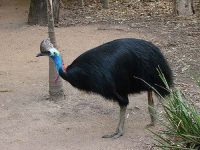Cassowaries are large flightless birds. They share their ratite group with some of the largest birds in the world—ostrich, emus, rheas, elephant birds, moas, and the smallest kiwis. There are four species of cassowary birds out of which one is extinct.
Cassowaries are some of the world’s heaviest birds—second only to ostrich in weight. They are the third tallest birds in the world.
Unlike males, females are not only highly colorful—they are bigger in size. Adult females reach a height of 4.9–5.9 feet but they can reach a size of 6.6 feet.
Cassowaries are found in northeastern Australia and New Guinea.
They will make habitats in tropical fore sts, grasslands, swamp forests, savanna, and palm scrub.
sts, grasslands, swamp forests, savanna, and palm scrub.
Cassowaries are omnivores as well as frugivores. They will consume fruits, green vegetation, grass seeds, snails, rats, flowers, frogs, birds, mice, fungi, fish, carrion, small invertebrates, shoots, fungi, and small vertebrates. Cassowaries also prefer to eat wild grape, podocarp, nightshade, apples, and bananas.
Cassowary birds will run at a speed of 31 miles per hour.
While cassowaries are extremely shy they have nevertheless strong defense against predators. They would use their dagger-like claws to cause severe injury to the predators even humans. Cassowaries have 5 inches long claws.
Southern cassowaries are believed to be the most dangerous birds in the world.
The breeding season ranges from May to June. The female lays as many as 3 – 8 eggs. The cassowary bird’s egg is pale green in color. A chick is born after an incubation period of 50 – 52 days.
Cassowaries are thought to live as much as 40 to 50 years in the wild.
Dogs and humans are probably the only predators of cassowary birds.
They do not seem to do well in captivity for cassowaries are adapted to living a solitary lifestyle.





